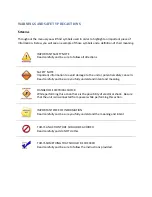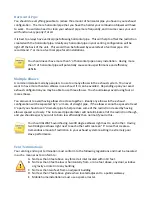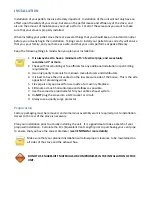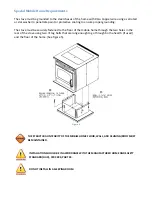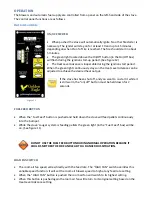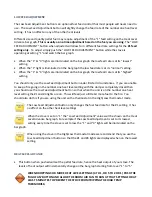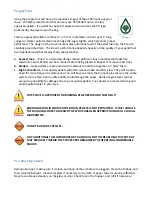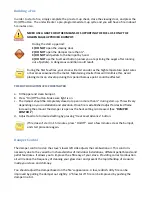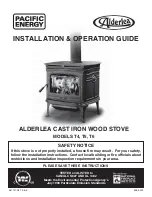
VENTING
The
choices
you
make
when
determining
how
your
vent
pipe
is
configured
is
very
important
and
will
have
an
impact
on
the
performance
of
your
unit.
In
order
to
get
the
best
performance
from
your
stove
we
highly
encourage
you
to
follow
all
installation
directions
in
this
manual.
It
will
save
you
a
great
deal
of
time
and
trouble
if
you
properly
vent
your
unit.
The
Monroe
is
certified
for
use
with
listed
TYPE
L
‐
Vent,
3”
or
4”
diameter
in
size.
The
stove
was
tested
with
Simpson
Duravent
brand.
Class
“A”
chimney
is
not
required.
Refer
to
the
instructions
provided
by
the
vent
manufacturer,
especially
when
passing
through
a
wall,
ceiling
or
roof.
THIS
IS
A
PRESSURIZED
EXHAUST
SYSTEM.
ALL
VENT
CONNECTOR
JOINTS
MUST
BE
SEALED
WITH
500
F
(260
C)
RTV
SILICONE
SEALANT
TO
ENSURE
CONSISTENT
PERFORMANCE
AND
AVOID
SMOKE
SPILLAGE.
ALL
HORIZONTAL
CONNECTOR
JOINTS
MUST
BE
SEALED
WITH
UL
‐
181
‐
AP
FOIL
TAPE.
DO
NOT
CONNECT
THIS
UNIT
TO
A
CHIMNEY
FLUE
SERVING
ANOTHER
APPLIANCE.
DO
NOT
INSTALL
A
FLUE
DAMPER
IN
THE
EXHAUST
VENTING
SYSTEM
OF
THIS
UNIT.
INSTALL
VENT
AT
CLEARANCES
SPECIFIED
BY
THE
VENT
MANUFACTURER.
Equivalent
Vent
Length
(EVL)
Prior
to
purchasing
your
pellet
vent
pipe
(type
L)
you
should
plan
your
venting
scenario
in
to
determine
the
diameter
of
vent
pipe
you
should
use.
Pellet
vent
pipe
comes
in
3"
and
4"
diameter.
In
order
to
determine
if
you
can
use
3"
diameter
pipe,
you
need
to
calculate
your
EVL
(Equivalent
Vent
Length).
To
properly
calculate
your
EVL
you
should
make
a
simple
sketch
of
your
planned
installation.
Then
use
the
figures
below
to
determine
your
EVL:
90
degree
elbows
or
cleanout
tees
count
as
5'
of
pipe
45
degree
elbows
count
as
3'
of
pipe
Pipe
running
horizontally
counts
as
1'
of
pipe
for
1'
of
pipe
Pipe
running
vertically
counts
as
1/2'
of
pipe
for
1'
of
pipe
Use
the
above
figures
to
calculate
what
your
planned
EVL
will
be.
If
your
EVL
is
less
than
15'
you
can
use
3"
diameter
pipe.
If
your
EVL
is
15'
or
more
you
should
use
4"
diameter
pipe.
If
you
need
to
use
4"
pipe
you
should
have
a
3"
to
4"
transition
right
off
the
back
of
the
unit
and
then
use
4"
diameter
pipe
throughout
the
entire
exhaust
system.
If
above
3,000'
in
elevation,
you
should
use
only
4"
diameter
pipe.
In
addition,
if
installing
the
unit
in
a
corner
and
going
out
a
sidewall,
we
highly
recommend
that
you
use
4"
pipe
regardless
of
your
EVL
or
elevation.
Summary of Contents for MONROE
Page 34: ...Electrical Diagram ...



